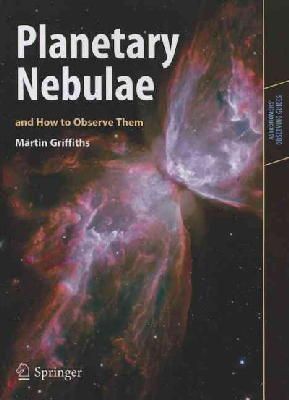17%OFF
Stock image for illustration purposes only - book cover, edition or condition may vary.
Planetary Nebulae and How to Observe Them
Martin Griffiths
FREE Delivery in Ireland
Description for Planetary Nebulae and How to Observe Them
Paperback. This book is for amateur astronomers who want to go beyond the Messier objects, concentrating on one of the most beautiful classes of astronomical object. It describes over 100 nebulae personally observed by the author using telescopes of various sizes. Series: Astronomers' Observing Guides. Num Pages: 302 pages, 292 black & white illustrations, 55 colour illustrations, biography. BIC Classification: PGM; WNX. Category: (P) Professional & Vocational. Dimension: 235 x 177 x 11. Weight in Grams: 534.
Planetary Nebulae and How to Observe Them is for amateur astronomers who want to go beyond the Messier objects, concentrating on one of the most beautiful classes of astronomical objects in the sky.
Planetary nebulae are not visible to the naked eye, but they are a fascinating group of telescope objects. This guide enables a user equipped with an average-sized amateur telescope to get the best out of observing them. Topics covered include their astrophysical make-up, history of their discovery, classification and description, telescopes to use, filters, and observing techniques - in short everything anyone would need to know to successfully ... Read moreobserve planetary nebulae.
The book describes the various forms these astronomical objects can take and explains why they are favorite targets for amateur observers. Descriptions of over 100 nebulae personally observed by the author using telescopes of various sizes are included in the book. Readers can create their own observing program or follow the list of these captivating objects, many of which are found within our own Milky Way Galaxy.
Show Less
Product Details
Publisher
Springer-Verlag New York Inc. United States
Series
Astronomers' Observing Guides
Place of Publication
New York, NY, United States
Shipping Time
Usually ships in 15 to 20 working days
About Martin Griffiths
Martin Griffiths is an enthusiastic science communicator, writer, and professional astronomer. Over his career he has utilized history, astronomy and science fiction as tools to encourage greater public understanding of science. He is a recipient of the Astrobiology Society of Britain's Public Outreach Award (2008) and the Astronomical League's Outreach Master Award (2010). He also holds the League's Master Observer ... Read morecertificate and has written or contributed to over 100 published science articles for many journals. He was one of the founder members of NASA's Astrobiology Institute Science Communication Group, which was active between 2003 and 2006; he also managed a multi-million pound ESF program in Astrobiology for adult learners across Wales between 2003 and 2008. Since then he has been involved in promoting adult education, assisting in the development of a new observational astronomy award at the University of Glamorgan and various other projects, including initial consultation on the setup of an observatory in Andalucía, Spain. He is a consultant to the Welsh government through his involvement with the Dark Sky Discovery initiative, enabling public access to dark sky sites in association with Dark Sky Wales, Dark Sky Scotland and Natural England. Martin is a Fellow of the Royal Astronomical Society and a member of the Astrobiology Society of Britain, the European Society for the History of Science, the British Astronomical Association, the British Science Association, the Webb Deep-Sky Society, the Society for Popular Astronomy, and the Astronomical League. He is also a local representative for the BAA Campaign for Dark Skies and is a member of the Honorable Society of Cymmrodorion, dedicated to promoting the literature, science and arts of Wales. Show Less
Reviews for Planetary Nebulae and How to Observe Them
From the reviews: “This is a welcome addition to the literature … . chapters discuss the history, discovery, and evolution of planetary nebulae. … these are well written and give a comprehensive and up-to-date account of the current ideas on planetary-nebula formation. … descriptions are largely accurate and the photographs have generally reproduced well. … A useful and comprehensive ... Read morelist of further reading covering many aspects of planetary nebulae is included … . this is a useful guide to observing these ‘butterflies’ of the night sky … .” (Stewart Moore, The Observatory, Vol. 132 (1231), December, 2012) “This book follows the standard pattern of the ‘… and how to Observe Them’ series with a brief section on the discovery of planetary nebulae followed by a section on how they form. … The book contains two chapters on observing techniques. … The book ends with a bibliography that is fairly extensive … . Planetary nebulae are some of the most popular objects that deep sky observers look for so … this is a decent first guide to observing these fascinating objects.” (Owen Brazell, Astronomy Now, August, 2012) Show Less

